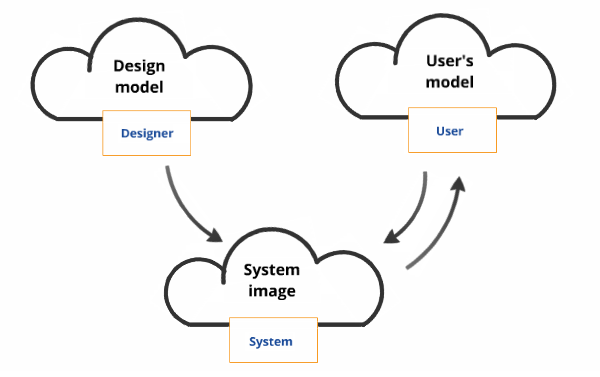Jobs such as “UI/UX Designer” are often advertised in France and some other countries – but you should think twice before applying even if you have a background in visual design. They may indicate that the company misunderstands UX or doesn’t really value it enough.
The real definition of UI
Before I tell you what’s wrong with these types of jobs, let’s remind ourselves what User Interface really means. UI is the medium through which the designer can communicate options to the user, and for the user to reply with their choices.
Usually it is a visual medium – Text, images, and buttons etc on a screen, but often it is non-visual, like when you phone an automated service and listen to the options, or feel vibrating feedback when you press a button on your touch-screen phone.
That’s why the image below of the user interface makes sense – It’s about dialogue and communication, not just visual design.

User Interface model from “The Design of Everyday Things” by Don Norman
The industry definition
When you see UX jobs advertised with “UI” or “designer” in the title, such as “UI/UX designer” what they usually mean is they want someone who is primarily a visual designer, but with an appreciation of UX – Someone that can work on a GUI or Graphical User Interface.
They’ll usually want the candidate to work on websites or software which will be used by the general public. They’ll need to compete with other sites or products on the open market, with a very polished, professional-level visual appearance – so the primary skill HAS to be visual design.
Why this is a problem
Visual design is too important to leave to a half-time person, and so it is with the UX strategy, analysis, and prototyping which serve as the foundation upon which the visual design will rest – not to mention the testing and other research methods needed to refine a product.
Furthermore, placing UI as equivalent to UX in a job title is a red flag – UI is a component of UX – and in fact when done well, UX will deal with the totality of the user’s experience with a company, service, or product, from website to in-store customer service. When the ‘UX’ work is targeted solely on the UI, you end up with a broken experience, as I wrote about when I was an Orange customer.
Now, of course it’s good for the visual designer or any other team member to have an appreciation of the whole of UX so they can work well with others in the team, or even do some parts of other closely-related functions.
But when you go further than that – when you want a UX Unicorn to handle everything, you get these problems:
- Jack of all trades, master of none – resulting in a mediocre product which is only as good as your weakest skill
- Spreading yourself too thinly – UX often needs the different functions to run in parallel, so this results in long hours and lots of workplace stress
- Conflicts of interest – user testing your own designs; or in periods of stress, reverting to your core skills such as making the interface look good at the expense of making it work well
Why these jobs are advertised
The fact that these job titles exist is due in my opinion to one or more causes:
- A lack of maturity in the market
- A poor of understanding of UX
- Not wanting to spend money on proper specialists because the company doesn’t really value UX
- The company can’t afford people with the correct skills to do the work
So jobs like “UI/UX Designer” ring all these alarm bells for me, which is why I steer clear of them, and that’s why you should too.
Situations where having a combination UI/UX designer might be acceptable
I can think of some jobs where the visual design burden will be low enough to allow you to do the other vital UX work, like hosting workshops or testing prototypes with users:
- You are making tools for internal company use only, and employees must use these tools and no others. In this case you will have a captive audience, and there is no need for an advanced visual design effort to seduce customers
- You are using a template – Most graphical elements have already been created and you can just drop them into place
- You are making desktop software using standard buttons, menus and other UI elements. You may only need occasional input from a visual designer for splash screens, etc
- You are working on a small project, with low time pressures, and with users who are not sensitive to how your product looks
If you are a UX professional or UX recruiter, let me know what you think in the comments below, especially if you disagree!
Hey,
Thanks for the interesting blog that I discovered today and this post in particular.
I share the thinking, though there is a common case were combining UI & UX makes a lot of sens: startups or small companies. At some point, a product comes from someone who can combine the skills: UX, UI, Product Management (and more…). Ultimately, I agree, I think the 3 above need to be disjointed – it’s not always possible, not in the beginning. It’s only for mature organizations.
I wanted also to comment more on the flipside, you could almost write the same blog post on the other side: “Avoid candidates who think they are UX/UI experts”. I have been hiring UI and UX persons the last 2 years, it is insane how many people would come to you mixing the too… This is a red flag of someone not being an expert and not knowing what he wants to do from his days.
Cheers